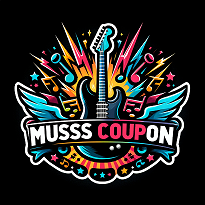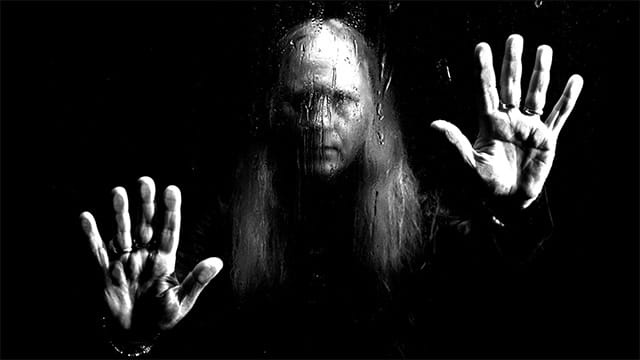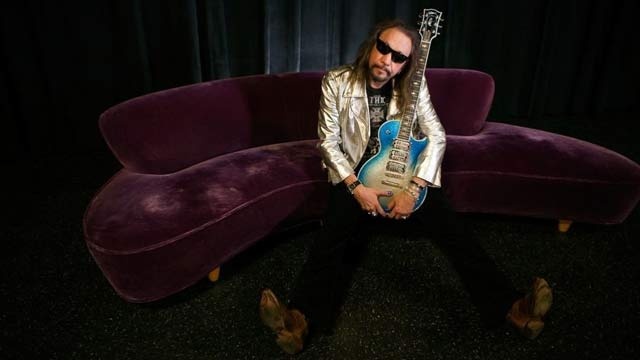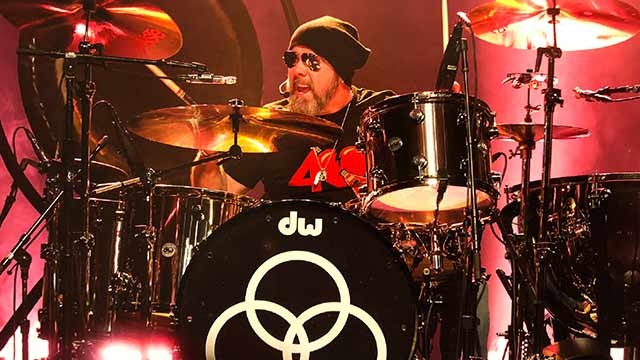Shortly before the album’s release, Cantrell chatted with AllMusic about the album and two of its standout tracks, in addition to songwriting, and if there can be another movement like grunge and alt-rock of the early ’90s.
How does I Want Blood differ from your previous solo albums?
“It’s nine new songs that weren’t on the last record. [Laughs] Stylistically, it’s a little bit different, too. [Brighten] was almost three years ago. That record was that time, and this record is its own space and time and collection of songs. I think that’s the cool thing about albums.”
“I don’t really think you can hold up any record I’ve ever done – whether it’s with Alice or outside of Alice – and say that any one of them sound like the other. Boggy Depot doesn’t sound like Degradation Trip, Degradation Trip doesn’t sound like Brighten, Brighten doesn’t sound like I Want Blood. But they’re all a cohesive piece of work, and hopefully, they sound like me.”
Let’s discuss some specific tracks off I Want Blood, starting with “Vilified.”
“That was a really energetic riff. Kind of an oddball, jagged time signature, too. And I like messing around with stuff like that. It naturally felt a little chaotic – but powerful and melodic, as well. I did a lot of ‘living room jams’ – I’ve got a little lowball set-up in the living room. Nothing fancy. Just a couple small amps, a keyboard, and an electronic drum kit. Gil Sharone, Tyler Bates, Lola Colette, Greg Puciato, Mike Bordin, Robert Trujillo, and Duff McKagan, in various combinations, whenever somebody had a week or two off from tour, we’d get together over here and just sort of jam through the ideas and mold through them.”
“The demo process for me is pretty consistent – no matter what group I’m working with or what configuration of people that I’m working with. It’s usually a demo process of me and someone else. Paul Figueroa is my longtime creative partner as far as demoing, and he’s engineered the last four or five records that I’ve done with Alice…and also on my own. He wasn’t going to be available on this one though, so Tyler Bates – my partner on the last record – recommended a really talented guy by the name of Max Urasky.”
“Max and I did the hard miles of the demo work – for about three or four months. And that’s consistent for me – it usually takes me three or four months of demoing and writing, and just pulling shit out of my ass and throwing stuff up against the wall and seeing what sticks, and trying to make some good tunes. And lastly, what are you trying to say now? Which is the toughest part for me. I don’t know about other musicians, but lyrics always are the most challenging. And it’s usually the last part of the process.”
“And then you figure out, ‘OK, who am I doing to record this with?’ So you call up all those fine folks that I just previously mentioned, and you get into a room and start shredding them out. And see who gravitates to what song. Maybe somebody’s strength speaks better on a different song than someone else, and just kind of naturally let everybody find their way to the song, and let the song find their way to them.”
“The configurations that you’ve got are on that record. ‘Vilified’ I believe are four people – it’s me on guitar and vocals, Robert Trujillo on bass, and Gil Sharone on drums…and I believe Vincent Jones plays a little bit of keyboard on that, too. It’s a four-piece, that song. Super energetic. There was a handful of songs that each player wanted to play on, and a couple of them ended up being the case – that was one.”
“I talked to Robert last week on the Metallica podcast [the Metallica Report], and he was like, ‘I wanted that song!’ But what Gil and Robert brought to that song made it what it is. I like to think I kind of elevated my play and definitely as a singer, took some chances and moved into some spaces that I normally might not have somebody else sing, because my voice doesn’t always translate to edge. I work better in the combination of a two singer configuration with the way that I write – I write for two voices.”
“But on this record in particular, and ‘Vilified,’ I felt pretty comfortable by the end of really pushing myself to maybe get into some vocal space and some performances where I felt like they were ‘owned.’ Like, I wouldn’t listen to it and go, ‘God, I wish I had somebody else sing that.’ I did the best I think that could have been done.”
‘So, that’s what you want. You want to be creating in an environment where you feel a little bit uncomfortable and you’re not sure if you can pull it off. That’s a great place to create from. Because it makes you really fight for everything that you get, and a lot of times, maybe the limits that you might have in your head of what you can do get surpassed – because you’re trying something new.”
And how about the song “Afterglow”?
“That’s another really special tune, and I’m glad they came out in that order. Just finishing up with ‘Vilified’ before we got on to ‘Afterglow,’ when I walk in with a group of songs, about 98% of the time I know where the album is going to start, and I know where it’s going to end. And ‘Vilified’ was always going to be the opener, for sure.”
“‘Afterglow’ was another song I thought was really special. And that is Duff McKagan on bass, Gil Sharone on drums, myself on vocals and guitar, and Vincent Jones on keys, and I think Lola does some vocals on it, as well. That’s just a really lush, beautiful, kind of melancholic song, too.
I never sit down with the intention of trying to do a certain thing, or make a certain type of song or make a certain type of record. But touching on certain elements, and those elements become their sound.
There is beauty and there’s some sadness to it. there’s some celebration and some remorse, as well. There’s a mix of emotions in that song. I think that’s part of the signature thing that I do. I don’t know why that is.”
“I never sit down with the intention of trying to do a certain thing, or make a certain type of song or make a certain type of record. But touching on certain elements, and those elements become their sound. And writing to me is not necessarily a straightforward conscious sort of thing – sometimes it’s a little bit grey. It’s a stream of consciousness kind of thing, and maybe you’re not writing just a single storyline. Maybe you have three or four different storylines – like different characters in a movie. And you can draw from all of those elements. And things can also be ‘dual’ – they can be both things at once. That way, it leaves the story open to interpretation. The only thing that really matters is if it seems to make sense as a story for itself.”
When you’re writing songs, how do you decide which songs will be for a solo album, and which will be for Alice in Chains?
‘Well, I wasn’t really planning on making a record with Alice during the time that I made this. If you look at my career, I’ve been with Alice since 1987, so that makes it 37 years. I’ve spent maybe six of those years making records outside [of Alice in Chains]. So all four of those records have basically been done in a six year window – in two separate sections.”
“So, it’s a little bit of a ‘full circle moment’ – Boggy Depot and Degradation Trip were done in a three-year window. And Brighten and I Want Blood are done in a two or three year window. I don’t get the opportunity to do it very much, so I really enjoy the times that it’s happened. It’s just something that I’ve felt organically at the time that I wanted to do.”
“Quite simply, answering your question, if I’m with Alice and we’re making a record and a song is written – it’s an Alice in Chains song, I guess. And if I’m working on a record for myself with other musicians, than it’s not.”
How do you find you write your best riffs?
“I’m a collector of riffs. And I think that’s the thing I do first and foremost. I don’t write all the time, but I am ‘collecting’ all the time. If I hear something in my head, I’ll hum it into my phone or if I’m playing guitar and I stumble across a riff or a little passage that I think is interesting or kind of perks up my ear. And sometimes – even more importantly – if I see somebody else react to it in a room. Like, ‘Hey, what’s that?'”
“If you don’t document them, they’ll float away. Some you’ll continually play subconscious, you just keep jamming a certain riff for a couple of years, and maybe somewhere down the road it makes its way into a song. If it’s something that kind of sticks around in your mental craw somehow and it’s something you always play, it’s probably a good chance somewhere down the road it’s going to make its way into a song. But, that’s not always the case.”
“Now that I’ve written this record, I probably won’t write again for another year or so. But I’ll be collecting the whole time. And I’ve already been collecting – I was sitting down for one hour with Tyler Bates yesterday, watching the Steelers lose to the Cowboys last night. And I think we came up with 16 ideas – just sitting there with two guitars, two guys, watching a football game, and a phone between us.”
“At the end of a period of time, I’ll have 50 or 100 or 150 riffs, and I’ll go through all of those. And a good portion of those, that’s the seeds of what a new album or a new work is going to be probably pulled from. And then once you get into that creative process, other things will just naturally happen in the moment because you’re in motion. So, new things will just happen spontaneously.”
What is your favorite guitar riff with Alice in Chains, and why?
“I don’t really have favorites. I don’t have a favorite color, I don’t have a favorite food, I don’t have favorite riffs. I mean, there are a lot of good ones. I mean, one of the first ones that still resonates today is one of my simplest riffs – the two note dirge of ‘Man in the Box.’ ‘Them Bones’ is a really cool, odd time signature riff.”
‘I think ‘Vilified’ is pretty fucking sick. [Laughs] ‘Check My Brain’ is a pretty unique one, as well. So, I don’t know – which kid do you like more on which day? You know what I mean? That probably changes – throughout minute to minute, hour to hour, which ones you’re favorite and your least favorite.’
“It Ain’t Like That” was a great riff, too. What do you recall about coming up with that?
“There’s a thing, the ‘bendy thing,’ is probably one of my signature kind of things that is in there somehow. And that was probably the first iteration of that sort of thing. And there’s a song on this record, ‘Let It Lie,’ which is a single note bend that’s pretty mammoth as well, and is in the lineage all the way to ‘It Ain’t Like That.'”
“I remember being at the Music Bank under the Ballard Bridge – where Layne and I lived. And we got a free room for running keys out to the rehearsal place. We were jamming, and the guys were making a comment about something they didn’t like that I was playing for them.”
‘And I’m like, ‘No, this is cool! What am I, going to play something stupid…like this?’ And I just kind of drew my strings from high string to the low string, and did a bend on the G – as a completely sarcastic response to them not liking something I was playing right before. And they’re all like,
You never know where you’re going to get your inspiration. And it really doesn’t matter. What does matter is if you’re able to touch it in the moment, to recognize it, get it down, and mold it into something.
‘Fuck! That’s cool, man! Do that again!’ And I’m like, ‘Are you kidding me?! I was being sarcastic!’ And they’re like, ‘I don’t care if you were being sarcastic…play that again!'”
‘They started playing along to it, and we made a song out of it. But it was just sort of a sarcastic response to being rejected for a different idea, and that riff came into being. So, you never know where you’re going to get your inspiration. And it really doesn’t matter. What does matter is if you’re able to touch it in the moment, to recognize it, get it down, and mold it into something.”
“Going back to what we were talking about previously, I’ve had many riffs drift off into the ether because I didn’t record them. I went to sleep and I’m like, ‘I’m not going to forget that,’ and then I wake up…and it’s gone. So, I’ve learned that even if it’s the most rudimentary thing, just a little hand-held mini tape recorder, to now it’s just really easy to use your phone…or a four-track…or Pro Tools…or whatever. Get the idea down so it’s documented, because you never know what it can turn into. It’s ‘money in the bank,’ so to speak.”
Layne Staley also came up with some of the riffs for Alice in Chains, such as “Angry Chair,” right?
“Yeah. And ‘Hate to Feel,’ as well – two of my favorite Layne songs. They were also based on the ‘bend kind of thing.’ That’s something that’s in the vocabulary of the band from an early on time. I think those songs both – ‘Head Creeps’ is another one – he used that bend in all three of those songs. But I think those two songs, he initially wanted to make a record on his own. He was a big fan of Ministry and Nine Inch Nails, so I think he was thinking maybe doing an industrial project with some other guys outside the band.”
“And I remember Sean [Kinney], Mike [Starr], and I were like, ‘Those are cool…we should record those. And he’s like, ‘Nah. I want to do them for something else. I don’t know if it’s really for this thing.’ So, we were just like, ‘Fuck you. We’re playing them.’ [Laughs] We learned them really quick and played them up. And it’s like, ‘Hey man, you get to play guitar on this, too. It’s an elevation of you as an artist and as a songwriter. And more importantly, they’re great songs.’ Those are three great songs – written completely by Layne. He wrote all three of those musically and lyrically.
Do you think too many modern day guitar players are overlooking the importance of the riff, and focus too much on the technical aspect of playing?
“I don’t think so. I think we’re all still ‘meat and potato riffs heads’ deep down. Even the super muso guys, everybody can recognize the power of a simple riff. Or, the simple arrangement of a cool rock song. It doesn’t have to be that technically brilliant to be a great song. But, even in a simple song, if you’ve got the chops to tear somebody’s face off technically over the top of that, that’s a pretty powerful combination.”
“I think that’s celebrated and venerated, for sure. I’m pretty sure Joe Satriani thinks ‘Iron Man’ is a pretty cool riff. I’m sure Steve Vai thinks that’s pretty cool, too. I’m sure both those guys have played the song ad nauseum – just as I have.”
Can there ever be another movement like the early ’90s grunge and alt-rock movement again?
“Of course. Because, it happened. Music is supposed to be a changing thing, and there’s supposed to be jagged breaks. Like, ‘OK, we’re done with this. This is the new thing.’ That’s just life. The one constant is change. I was part of a generation – not just in my town, across the globe – of young artists stumbling on to something new. And even though we weren’t all working together, we were kind of psychically connected to a change. You could feel it. We all were of a generation that really were turning each other on to all of these new, young artists, and sharing music, and we all loved rock n’ roll. We were probably all within the same handful of years of age.”
“It doesn’t happen on that sort of a scale – let alone in your hometown. And to be connected to a greater movement across the globe with artists from all over the world together being part of a cultural shift in music. But just the fact that that happened…it’s happened before. And it’s happened before us and it would be pretty impossible if it doesn’t happen again. Usually, every three to five years. Before what happened in the ’90s, it was always shifting. And I think it still has shifted.”
“Maybe it’s harder to see and feel, because of the diffuseness of so much stuff out there. Maybe the lack of support to develop artists and stick with them for three, four, five albums. Maybe it’s a little more difficult for those things to happen in the way that they happen. But it’s happening right now. It just depends on if the world pays attention to it or not. So, that’s the cool thing about rock n’ roll – the music is always changing, life is always changing, styles are always changing. Whether you pay attention to it or not is the question. It’s always going on.”
For more info, visit jerrycantrell.com.



